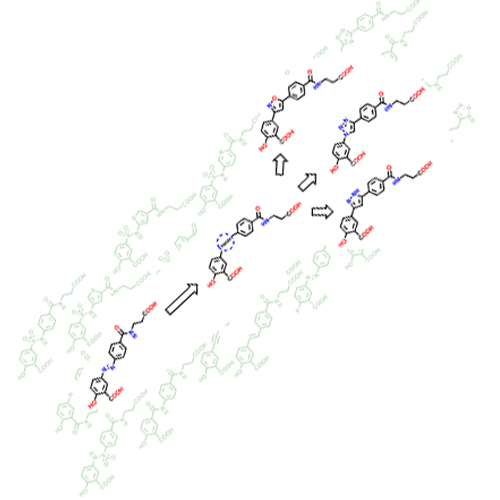Development of hetero-triaryls as a new chemotype for subtype-selective and potent Sirt5 inhibition
2022-07-08
Carina Glas, Eli Naydenova, Severin Lechner, Nathalie Wössner, Liu Yang, Johannes C.B. Dietschreit, Hongyan Sun, Manfred Jung, Bernhard Kuster, Christian Ochsenfeld, Franz Bracher
European Journal of Medicinal Chemistry, 2022, Volume 240, 114594
https://www.sciencedirect.com/science/article/abs/pii/S0223523422004962?via%3Dihub
In contrast to other sirtuins (NAD+-dependent class III lysine deacylases), inhibition of Sirt5 is poorly investigated, yet. Our present work is based on the recently identified Sirt5 inhibitor balsalazide, an approved drug with negligible bioavailability after oral administration. After gaining first insights into its structure-activity relationship in previous work, we were able to now develop heteroaryl-triaryls as a novel chemotype of drug-like, potent and subtype-selective Sirt5 inhibitors. The unfavourable azo group of the lead structure was modified in a systematic and comprehensive manner, leading us to a few open-chained and, most importantly, fivemembered heteroaromatic substitutes (isoxazole CG_209, triazole CG_220, pyrazole CG_232) with very encouraging in vitro activities (IC50 on Sirt5 in the low micromolar range, <10 μM). These advanced inhibitors were free of cytotoxicity and showed favourable pharmacokinetic properties, as confirmed by permeability into mitochondria using live cell imaging experiments. Furthermore, results from calculations of the relative free binding affinities of the analogues compared to balsalazide as reference compound agreed well with the trends for inhibitory activities obtained in the in vitro experiments. Therefore, this method can be used to predict the affinity of closely related future potential Sirt5 inhibitors. Encouraged by our findings, we employed chemoproteomic selectivity profiling to confirm Sirt5 as main target of balsalazide and one of its improved analogues. An immobilised balsalazide-analogue specifically pulled down Sirt5 from whole cell lysates and competition experiments identified glutaryl-CoA dehydrogenase (GCDH) and nucleotide diphosphate kinase (NME4) as potential off-targets, once again confirming the selectivity of the novel balsalazide-derived Sirt5 inhibitors. In summary, a combination of targeted chemical synthesis, biological work, and computational studies led to a new generation of tailored Sirt5 inhibitors, which represent valuable chemical tools for the investigation of the physiological role of Sirt5, but could also serve as advanced lead structures for drug candidates for systemic use.








